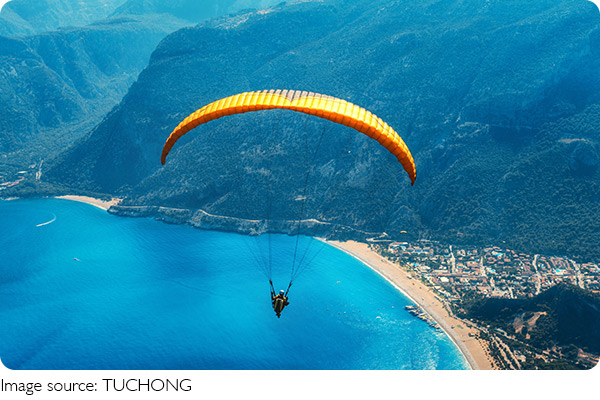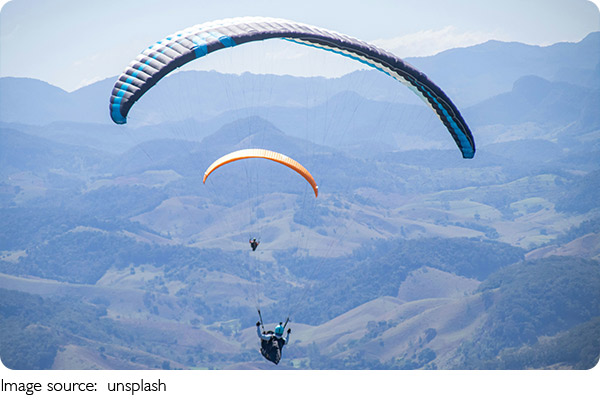Fun Flight

Have you ever dreamed of soaring through the skies, feeling the wind rush past you as you glide through the air like a bird? Paragliding is an extreme sport that allows us to experience the thrill of free flight without the need for a lot of strength or expensive equipment.
So, let’s dive into the world of paragliding and explore what makes this sport so exciting and accessible!
Learning to Paraglide [What it's REALLY like]
Video by Passion Paragliding
What is Paragliding?
Paragliding, or as it’s sometimes known as a "flying parachute," is an extreme sport where we use a lightweight, free-flying glider to soar through the skies. Unlike skydiving, where we jump from an aircraft, paragliding involves taking off from a mountain hillside or using towing methods. The equipment used is relatively light—around 20 kilograms—and the setup consists of a main parachute, a harness, and a backup parachute (often referred to as a reserve). Modern paragliders are capable of reaching heights of up to 4,000 meters and flying distances of over 400 kilometers!
The Origins of Paragliding
Did you know that the concept of paragliding was first introduced by NASA? Originally, it was meant for recovering space equipment. However, after some challenges, this concept was abandoned, and it later evolved into an extreme sport. Paragliding became a way for humans to achieve the dream of free flight, using some of the most affordable and compact gear available today. It’s an accessible sport that can be enjoyed with an initial investment of around 100,000 TWD in equipment.
Essential Paragliding Equipment
Paragliding requires three main pieces of equipment:
Main Parachute: The glider itself, designed for flight. It has a wing shape that differs from a regular parachute, allowing us to control our descent and glide smoothly.
Harness: This is where we sit during the flight. It’s made of durable materials and is attached to the parachute with suspension lines.
Backup Parachute: This is a life-saving piece of equipment. If the main parachute fails, the backup can be deployed to ensure a safe landing.
Additionally, paragliders often use tools like GPS devices and radios for better navigation and communication.
How Does Paragliding Work?
Taking Off: Paragliding requires a mountain hill with a 15-degree incline and a wind facing us. After inflating the parachute above us, we start running, and once we reach the required speed, we are lifted off the ground. It’s all about catching the wind just right! For experienced pilots, takeoff is quick and smooth, often within a few steps.
Turning: Paragliders are fully controllable. By pulling on the brake handles on either side of the glider, we can increase drag on one side, causing the glider to turn in that direction. The more we pull, the sharper the turn.
Climbing: Paragliders don’t have engines, so we rely on external forces like thermals (rising air currents) to gain altitude. In good weather, we can climb up to heights of 2,000 to 4,000 meters. On windy days, we can also use mountain ridges to help us soar higher.
Descending: Without external assistance, paragliders descend at a rate of about 1 to 1.5 meters per second. It’s a smooth glide, and pilots control their descent by adjusting the brakes.
Safety Measures and Emergency Procedures
Paragliding is an exciting sport, but safety is key! While the sport is thrilling, we should always be prepared for emergencies:
Big Ears: By pulling on the outermost suspension lines, we can reduce the wing’s surface area, which increases our descent rate. This maneuver is helpful in certain conditions but requires careful execution.
B-Stall: Pulling on the B-group lines can cause the glider to stall, increasing the descent rate dramatically. It’s a controlled maneuver used in emergencies.
Spiral Dive: This is a high-speed descent where the glider spirals downward, and pilots need to have advanced skills to control it safely.
Risks of Paragliding
Like any extreme sport, paragliding comes with risks. The most significant threat is falling from high altitudes, particularly if the glider doesn’t recover quickly. There are also potential dangers from unpredictable weather conditions or sudden changes in wind patterns. But with proper training and precautions, many of these risks can be minimized. Most pilots undergo thorough training and use specialized insurance to cover accidents.
Landing Smoothly
Landing a paraglider is very different from parachuting. We land softly by facing into the wind, and at the last few meters, we apply brake control to slow our descent to almost zero speed. This makes for a gentle, controlled landing.

Should You Try Paragliding?
If you’re looking for an adrenaline-packed adventure that lets you experiencll of flying, paragliding might just be the perfect sport for you! With the right training and equipment, it’s a safe and exciting way to enjoy the beauty of the skies. We highly recommend trying it at least once—who knows, it might just become your new favorite sport!
So, what do you think, Lykkers? Are you ready to take flight?

 · Sport Team
· Sport Team